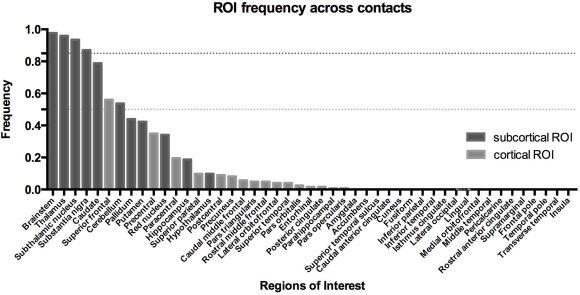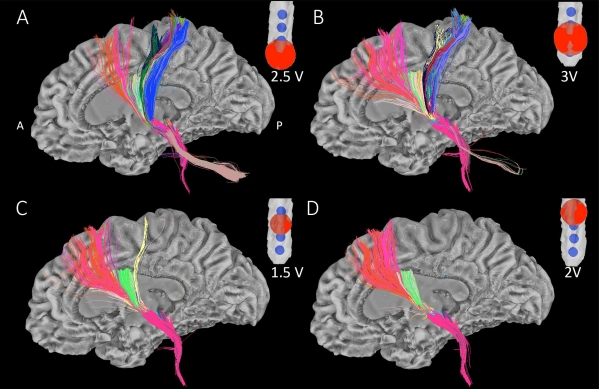Session Information
Date: Monday, June 20, 2016
Session Title: Surgical therapy: Parkinson's disease
Session Time: 12:30pm-2:00pm
Location: Exhibit Hall located in Hall B, Level 2
Objective: To assess the connectivity patterns that characterize clinically beneficial electrodes in Parkinson’s disease patients, after deep brain stimulation of the subthalamic nucleus.
Background: Deep brain stimulation therapy is an effective symptomatic treatment for Parkinson’s disease, yet the precise mechanisms responsible for its therapeutic effects remain unclear. Although the targets of deep brain stimulation are gray matter structures, axonal modulation is known to play an important role in deep brain stimulation’s therapeutic mechanism. Several white matter structures in proximity to the subthalamic nucleus have been implicated in the clinical benefits of deep brain stimulation for Parkinson’s disease.
Methods: We evaluated 22 patients with Parkinson’s disease (11 females, age 57 ± 9.1 years, disease duration 13.3 ± 6.3 years) who received bilateral deep brain stimulation of the subthalamic nucleus at the National Institutes of Health. During an initial electrode screening session, one month after deep brain stimulation implantation, the clinical benefits of each contact were determined. The electrode was localized by coregistering preoperative MRI and postoperative CT images and the volume of tissue activated was estimated from stimulation voltage and impedance. Brain connectivity for the volume of tissue activated of deep brain stimulation contacts was assessed using probabilistic tractography with diffusion-tensor data.
Results: Areas most frequently connected to clinically effective contacts included the thalamus, substantia nigra, brainstem and superior frontal gyrus  . A series of discriminant analyses demonstrated that the strength of connectivity to the superior frontal gyrus and the thalamus were positively associated with clinical effectiveness
. A series of discriminant analyses demonstrated that the strength of connectivity to the superior frontal gyrus and the thalamus were positively associated with clinical effectiveness  .
.
Conclusions: The connectivity patterns observed in our study suggest that the modulation of white matter tracts directed to the superior frontal gyrus and the thalamus is associated with favorable clinical outcomes and may contribute to the therapeutic effects of deep brain stimulation. Our method can be further developed to reliably identify effective deep brain stimulation contacts and aid in the programming process.
To cite this abstract in AMA style:
N.S. Vanegas-Arroyave, P.M. Lauro, L. Huang, M. Hallett, S. Horovitz, K.A. Zaghloul, C. Lungu. Tractography patterns of subthalamic nucleus deep brain stimulation [abstract]. Mov Disord. 2016; 31 (suppl 2). https://www.mdsabstracts.org/abstract/tractography-patterns-of-subthalamic-nucleus-deep-brain-stimulation/. Accessed April 20, 2025.« Back to 2016 International Congress
MDS Abstracts - https://www.mdsabstracts.org/abstract/tractography-patterns-of-subthalamic-nucleus-deep-brain-stimulation/
